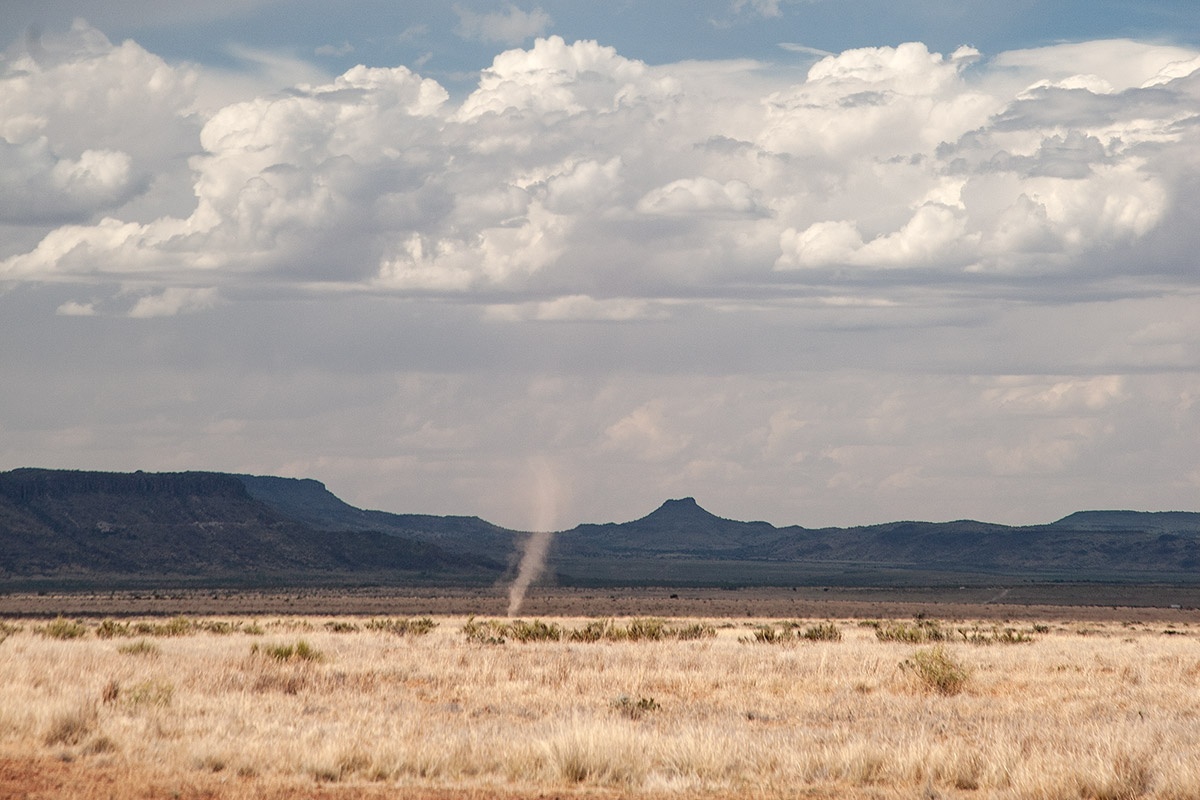As I crossed the Serengeti in a mud-covered Land Rover, a dust devil suddenly appeared in the dirt road ahead, as if summoned by wizardry.
“Kimbunga!” my guide shouted in Swahili.
The rogue dervish spun up from the red volcanic soils that cover the grassland plain. It traced our route, leading the way down bumpy ruts, drawing us farther into a wild and mysterious place. There was something transformative about the way it spun the landscape into a scene from my West Texas home, a similar basin-and-range topography abundant with its own special wild things.
Whether it’s an East African kimbunga or a West Texas dust devil, whirlwinds occur wherever and whenever conditions are right. The formula calls for specific circumstances: a dramatic change in temperature caused by warm air that creates an updraft as it rises from the ground through cooler air above. Add a light wind that encourages horizontal rotation and forward momentum, and a whirlwind is born.
Studies suggest that these spinning columns of air occur all the time in the first several hundred feet of atmosphere above the Earth’s surface. We’re able to witness this phenomenon when the up-draft is strong enough to lift sand, soil and ash from the ground to form a visible vortex—a dust devil—that can rise several hundred feet. The warmer air rising creates a void for more warm air to replace it, then cools in the upper layers before exiting the chimney. The cooled air sinks around the outer chimney walls, helping to stabilize the dust devil. Altogether, these factors produce a self-sustaining engine that transports air forward, around, and up and down like a moving, spinning elevator. A tornado, on the other hand, forms from the updraft of a supercell thunderstorm.
Disruption, a common denominator of change, is usually responsible for the dust devil’s demise. Once a whirlwind’s careful balance of upward and circular movement is disrupted, by a slight decrease in surface temperature, a sudden rush of cold air sucked into the warm void or a topographic bump along the travel route, the dust devil quickly collapses like a magician in a puff of smoke. The magic is real but fleeting.
Magic is an apt descriptor for whirlwinds, particularly if you consider “magic” a romantic word for science. Whirlwinds do not discriminate, and they lift anything that isn’t heavy enough to remain on the ground. You’ll find sand devils among dunes, steam devils around power plants, coal devils in mining country and snow devils on ski slopes. With luck, you might also see a hay devil forming over fresh-cut fields of summer.
They also occur on Mars. Dust devils were first photographed on Mars by orbiters, part of NASA’s Viking program in the 1970s. Since then, Mars rovers Pathfinder and Spirit have documented dust devil activity. The red planet is a hotbed of atmospheric instability, spawning about two dust devils per square mile per day, on average. According to scientists, Martian dust devils play an integral role in the planet’s weather and climate, dispensing particles into the atmosphere, where they help retain heat, which can measure 68 degrees at the equator.
Martian dust devils have also assisted in their own research. Whirlwinds have lifted dust from solar panels and instrumentation on NASA probes, which can be hampered by particulate buildup. Any passing dust devil simply cleans up like a housekeeper, allowing the technology to function at full capacity.
That day on the African veld, the kimbunga was the first of many we would see as the afternoon heated up, as if someone had slowly let loose a box full of whirligigs to race across the landscape. I felt the country’s kinship to West Texas a few more times until a herd of giraffes appeared on the horizon, a clear sign that I was traveling across an unfamiliar continent.
In many ways, East Africa is as different from home as Earth is from Mars. But a life of travel often leads to enlightenment, suggesting that no matter how strange or alien a place may appear, you can always find something in common, whether it’s a dust devil or otherwise on the opposite side of Earth or millions of miles away, on another planet.
Photographer, author and artist E. Dan Klepper lives in Marathon.


